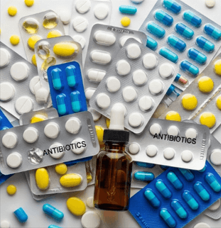Treatment Overview
Antibiotic therapy is a widely used treatment in Korea for redness and flushing associated with rosacea, inflammatory acne, and sensitive vascular skin. Oral antibiotics such as doxycycline, minocycline, and azithromycin are commonly prescribed for their anti-inflammatory and anti-angiogenic properties, which help reduce vascular reactivity and skin inflammation rather than simply targeting bacteria.
Korean dermatology clinics often use antibiotics as part of a multi-step redness control program, combining them with lasers, soothing infusions, and barrier repair treatments. This approach aims to reduce acute redness while also preventing relapses and improving skin tolerance.
For redness and flushing, Antibiotic Therapy:
- Reduces inflammation and vascular sensitivity.
- Improves rosacea-related redness and papules.
- Controls secondary infection risks in sensitive skin.
- Enhances results when combined with laser or topical therapy.
Purpose & Benefits
- Anti-Inflammatory Effect: Suppresses cytokines and vascular inflammation.
- Redness Reduction: Decreases flushing and rosacea-related erythema.
- Vascular Stability: Helps reduce frequency of flushing episodes.
- Adjunct to Lasers: Improves healing and synergizes with anti-redness laser programs.
- Long-Term Control: Maintains remission when used under dermatologist supervision.
Ideal Candidates
Antibiotic Therapy in Korea is recommended for:
- Patients with rosacea and persistent flushing/redness.
- Individuals with papulopustular rosacea (red bumps with vascular sensitivity).
- Those experiencing post-acne erythema with inflammation.
- Patients preparing for or recovering from laser treatment.
- Adults seeking systemic support for redness not controlled by topicals alone.
Comparison with Other Treatments
- Antibiotics (Doxycycline, Minocycline, Azithromycin): Strong anti-inflammatory and vascular stabilizing effect; systemic approach.
- Anti-Redness Lasers (PDL, V-Beam, Nd:YAG): Target blood vessels directly; most effective for persistent vascular redness.
- Topical Creams (Metronidazole, Ivermectin, Brimonidine): Local redness control, but limited systemic impact.
- Barrier Repair Creams (Centella, Panthenol, Madecassoside): Strengthen skin, but don’t reduce deep vascular activity.
- Oral Beta-Blockers (Propranolol, Clonidine): Control flushing episodes, but not inflammation.
- LED/Light Therapies: Calm skin, but weaker effects on rosacea compared to antibiotics + lasers.
Possible Risks & Complications
While safe when supervised, antibiotics may cause:
- Gastrointestinal upset (nausea, diarrhea).
- Photosensitivity (especially doxycycline).
- Yeast overgrowth or microbiome imbalance with prolonged use.
- Resistance if misused or overused.
- Pigmentation changes (rare, with minocycline).
Treatment Techniques Used
- Oral Antibiotics: Typically low-dose doxycycline (sub-antimicrobial dosage) for redness.
- Frequency: Daily or alternate-day dosing for 8–12 weeks, sometimes longer for chronic rosacea.
- Combination Therapy: Paired with topical anti-redness creams or vascular lasers.
- Clinic Integration: Korean clinics often add soothing infusions, cryotherapy, or LED light for faster recovery.
Recovery & Aftercare
- First Week: Reduced flushing intensity and skin sensitivity.
- 2–4 Weeks: Noticeable reduction in diffuse redness and papules.
- Maintenance: Antibiotic tapered or rotated with topical/laser therapy for sustained remission.
Aftercare Tips:
- Avoid sun exposure; use high-SPF sunscreen daily.
- Follow prescribed dosage—do not stop abruptly without medical advice.
- Pair with probiotics or gut-supportive diet if used long-term.
- Maintain gentle skincare with barrier creams and avoid harsh actives.
Results & Longevity
- Short-Term (1–2 Weeks): Flushing episodes decrease, redness less intense.
- Medium-Term (1–2 Months): Skin tone more stable, rosacea papules reduced.
- Long-Term: With combination therapy, remission can last months to years, with occasional maintenance.
Treatment Process in Korea
- Consultation & Diagnosis – Dermatologist evaluates severity of redness and rosacea subtype.
- Prescription – Antibiotic chosen (often doxycycline at low anti-inflammatory dose).
- Usage Instruction – Dosing tailored to skin type, sensitivity, and lifestyle.
- Clinic Add-Ons – Laser, soothing infusions, or LED therapy for faster redness relief.
- Follow-Up – Treatment tapered, rotated, or switched to topicals to prevent long-term resistance.
Why Korea is a Top Destination
- Emphasis on low-dose, anti-inflammatory antibiotic protocols to minimize side effects.
- Integrated approach: antibiotics combined with laser, infusions, and barrier programs.
- Affordable consultations and advanced monitoring compared to Western dermatology.
- Focus on skin-soothing regimens that reduce irritation from systemic therapy.
- Korean dermatologists are global leaders in rosacea and vascular skin research.
Cost Range (Detailed Breakdown)
Pricing for Antibiotic Therapy in Korea for redness & flushing:
- Consultation Fee: USD 20 – 50.
- Prescription Antibiotics (1 Month Supply): USD 10 – 40.
- Bloodwork / Monitoring (if needed): USD 30 – 70.
- Combination Clinic Session (Antibiotics + Infusion / Cooling / LED): USD 80 – 200.
- Premium Redness Control Program (Antibiotics + Lasers + Barrier Infusions): USD 600 – 1,500 (3–5 sessions).
Additional Costs in Korea:
- Probiotic or gut support supplements: USD 20 – 60.
- Barrier creams for sensitive skin: USD 30 – 80.
💡 Patients often call antibiotics the “internal anti-redness pill,” since they calm inflammation and vascular activity from within, especially when external treatments alone are not enough.
Popular Clinics in Seoul
- Oracle Dermatology – Doxycycline + V-Beam laser programs for rosacea.
- Banobagi Dermatology – Antibiotics integrated with redness infusion therapy.
- Renewme Skin Clinic – Low-dose antibiotics + topical anti-redness regimen.
- View Plastic & Dermatology – Combined systemic + vascular laser care.
- Chaum Anti-Aging Center – Premium rosacea programs with antibiotics, infusions, and laser.




